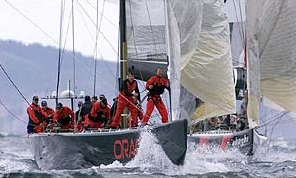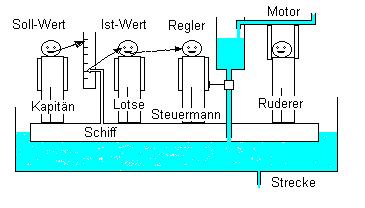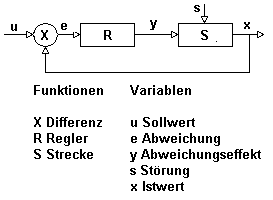| Hypercommunication - Crash Courses - Second-order Systems Theory [ Hyper-Library ] [ Hyper-Lexicon ] [ back ] |
|
|
backward - Page 6 - forward |
|
Naively (note 1) interpreted, systems theory is a theory about systems. What I understand as systems theory, I explain by saying how I use the terms theory and system. I call a system a regulated mechanism exactly when I describe its behaviour in the explanation of a phenomenon. And I call theories argumentations, in which an explanation of a phenomenon is transferred to a theoretically analogous phenomenon. A theory describes the meaning of an explanation within a context designated by the theory note 2). I will give a historical example of this, which I will take up from the Kybernetes (helmsman) by N. Wiener. I can ask myself how a ship reaches a certain destination (in a regatta faster and safer than other ships). In the everyday sense, I know that the ship has to be propelled and steered to achieve this. The crew of the ship reacts to deviations from the target course by following the steering and propulsion. The pilot, as part of the crew, observes deviations of the actual value from the target value, which he receives from the captain. He reacts to each deviation with a corrective action, which is carried out by the crew. The crew of a ship can be replaced by a so-called autopilot, i.e. a mechanism that performs the same function. When I describe the autopilot as a system, I have also theoretically described what the crew of the ship does. The helmsman metaphor was adopted by J. Watt from Plato - who left the propulsion to the slaves - who compared the task of the prince (the political gubenator) with that of a ship's helmsman. As far as the metaphor carries, the ship's steering also describes what the Platonic princes do (note 3). In this colloquial sense, I use systems theory to describe the behaviour of machines, people and societies, or rather everything that I can understand as behaviour. The description of the construction of the autopilot serves as an explanation of how a particular ship reaches its destination. And it serves as an explanation of how the Platonic nations achieved their goals. I develop the essential concepts of my systems theory on the basis of constructions that I can use to generate the respective phenomenon to be explained. In the typical case of system theory, the procedure described here is not used to generate the phenomenon of interest, but to construct a model. For example, if I want to explain lightning at thunderstorm sky, I can?t describe - at least for the time being - a procedure by which I can produce the lightning. However, I can describe procedures with which I can produce a comparable phenomenon, for example a spark, which I consider a model of lightning. When I describe the mechanical autopilot of a ship, I have not described a ship's company or crew, but at most a model of the crew, in which only very specific operations are abstracted. In my opinion, theories have the function of making systematic explanations plausible by showing the analogy between the explained phenomenon and the phenomenon to be explained, for example between spark and lightning. The theory of evolution, for example, explains to what extent nature behaves like a breeder who selects from variation. I consider systems theory to be merely a special case of theory at all - whereby systems theory is also an explication of what theory should mean. |



|
The function of my systems theory is therefore, on the one hand, in a practical, ingenious sense, to make complex phenomena constructively understandable. The theoretical function is to make understanding itself understandable. The most complex phenomenon is, of course, that I can perceive and explain phenomena at all. With my systems theory I explain to myself what I am doing - but I can only do so by shifting problems, such as from lightning to spark. I understand certain things very well, but they are not the things I naively wanted to understand. Systems theory explains to me what I explain and how.
Erklärungen sind quasi tautologisch, wenn sie den Mechanismus selbst betreffen, und hypothetisch, wenn sie ein nicht konstruierbares Phänomen wie etwa Blitze betreffen.
|
|
backward - Page 6 - forward |